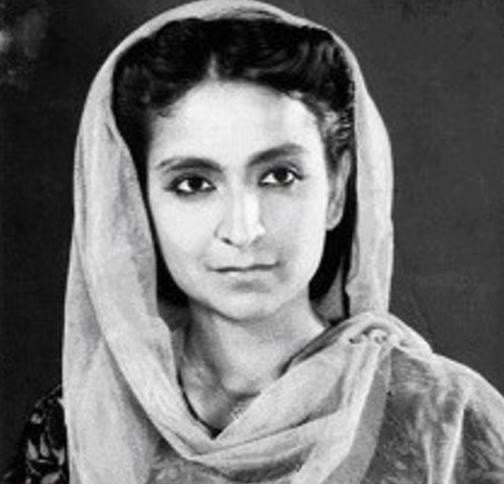A tribute to the fearless poet and litterateur on her 103rd birth anniversary.
by Lily Swarn
When a man denies the power of women, he is denying his own subconscious.
~ Amrita Pritam
Born Amrit Kaur in Gujranwala , Punjab in British India (now Pakistan) in 1919, Amrita Pritam went on to become the first and only woman to get the Sahitya Academy Award in 1956 for a work in Punjabi – Sunehede. She was also the first to get the Punjab Rattan Award. Amrita was a novelist, essayist and poet all rolled into one who wrote extensively in Punjabi and Hindi.
Amrita was vastly different from the millions of subjugated women of her times for she dared to live life on her own terms – with boldness and grit – paving the path for young girls to write fearlessly.
In one of her not-so- famous poems, Apne Naal Mulaqaat ( Meeting the Self), she speaks up clearly and loudly, regardless of her gender .
Amrita’s imagery was visceral and she was charged with obscenity by the government of Punjab, even for a poem she dedicated to Guru Nanak. She lived her life with her own mind, whether it was cutting her hair short, smoking or drinking. She shocked many sensibilities while she spoke of equal love.
This is what she said in an interview to Rama Jha: “Man has not yet tasted the friendship and company of a liberated woman as an equal partner. Men and women have not yet met as two independent human beings. If men and women are not economically independent, how can they love? Generally women love out of a sense of insecurity. Love is admiration and companionship of the other person. Economic enslavement obstructs the experience of love.”
Her body of work comprises over 100 books of poetry, fiction, biographies, essays, a collection of Punjabi folk songs and an autobiography that are all translated into several Indian and foreign languages.
When I was asked to write a tribute for this fearless writer on her 103rd birth anniversary, I wondered what more could I possibly write about a lady who has so much written about her already.
In her radio autobiography, Amrita mentions that her father lived in the Aashram of Dayal Sadhu in his earlier years and was known as Baalka Sadhu. Women who came to do puja were smitten by his enormous charm and good looks. They waited to see which woman’s offering of food the handsome, sharp featured sadhu would eat that day. Among the visitors to the Ashram was the devastatingly attractive Raj Bibi, whose husband, having joined the army soon after their wedding, left home never to come back .One day Dayal ji noticed Baalka Sadhu’s strangely damp eyes flitting repeatedly towards Raj Bibi’s face as he recited his poetry on a rainy evening. Dayal ji advised him to renounce his ascetic way of life and marry her. Amrita believed that her poetry and the harsh realities of life were a legacy from her parents. Her father, later known as Kartar Singh Hitkari, an esteemed scholar and a preacher in his spare time was editor of a literary journal. She recounts that her father was cheated of a trunk full of gold coins by the person he had entrusted them to for safekeeping .Her mother, who was teaching in a school in Gujranwala, passed away when Amrita was only ten and a half years old. She shares in her radio autobiography that her maternal aunt Jamuna confided that Raj Bibi was spurned by her in-laws for her life’s choices.
Amrita shifted to Lahore with her father. Her lonesome life found an outlet in writing. Her father would also write all night long and sleep in the day time .The house was chock-a-block with books.
Amrita says that she felt as if she was one of those books on the shelf. The only difference being that this book had empty pages. This deep despondency weaved magic with her pen. She published her first collection of poems titled Amrit Lehraan (Immortal Waves ) in 1936 when she was barely 17. It is believed that her writing, then considered audacious, smacking of strength and independence was triggered by her colossal sense of loss .She also mentions that a lot of her writing was an unconscious or conscious means of giving words to her father’s ominous silences after he was shattered by his wife’s untimely death.
In 1935, when she was just 16, Amrita was married off to Pritam Singh, son of a well off hosiery merchant of Anarkali Bazaar in Lahore.
Her autobiographies later revealed that the marriage was strained and unhappy.
In 1944, Amrita met Sahir Ludhianvi who later went on to become Indian cinema’s ace lyricist. They met at a mushaira in Preet Nagar, Lahore and an instantaneous connect was palpable. There was a powerful attraction between them even while she was married to the man whose last name she had added to hers. This was the beginning of an intense relationship.
There is a lot written about this relationship in Mai Sahir Hoon by Chander Verma and Dr. Salman Abid. Sahir has supposedly said that they were meeting more often and that they were drawn towards each other. They would write nazms for each other. The book also reveals that Amrita’s 13 year old son once asked his mother if he was ‘Sahir uncle’s’ son. He urged her to answer truthfully as he liked his Sahir uncle. No, said Amrita, while admitting that she too liked Sahir.
When they finally parted, this is what Sahir wrote for her:
tum chali jaogi parchhaian reh jaayengi
har taraf ishq ki ranaian reh jaayeingi
The poem was composed by music director Khayyam in Mohammad Rafi’s voice in the 1964 movie Shagoon. It is said that ‘ishq’ was replaced by ‘husn’ on Sahir’s request.
Pakistani activist and Amrita Pritam’s dear friend, the late Fahmida Riyaz, wrote a piece Amrita ki Sahir se Aakhri Mulaqaat – Amrita’s Last meeting with Sahir – in the Urdu daily Jung in Pakistan. Their parting meet was overly poignant.
Amrita openly writes about her unrequited affection for Sahir in her autobiography, Rasidi Ticket.
She was so much in love with Sahir that she picked up stubs of cigarettes after he had smoked them gazing deep into her eyes. She mentions that they would sit for hours together. He was in the habit of smoking half a cigarette and then lighting a fresh one .Once he went away, she inhaled the smell left in the air and then would hold the stubs in her fingers. She soon got into the habit of puffing on them.
Akshay Manvani, in his book Sahir: A People’s Poet, writes that though there were other women in Sahir’s life , he had told his mother Sardari Beghum that Amrita could well have been her daughter-in-law .
At the time of partition in 1947, Sahir went off to Mumbai and Amrita came to Delhi. The aftermath of this brutal divide left a horrific effect on Amrita. Watching the raping and killing on her journey to India made her invoke the famous 18th century Punjabi poet Waris Shah who had written about the pain of the legendary Heer. Her expression of anguish at the cold blooded massacres cleaves through the poem that she wrote.
Amrita joined the Progressive Writers Movement to inspire the youth. As a novelist, her most important work was Pinjar ( The Skeleton), written in 1950. She created her memorable character, Puro who represents the epitome of virulence against women, loss of humanity and ultimate surrender to fate. It was later made into an award winning film of the same name in 2003.
Amrita found true love in the supportive companionship of writer and artiste Inderjeet Imroze .He designed most of her book covers and also made her the subject of many of his paintings .A book was written about their life – Amrita Imroze: A Love Story. They were together for the last 40 years of her life in a live-in relationship but never married in any religious or legal sense. He looked after her with utmost devotion even in the days she was bedridden.
When Imroze went to drop Amrita to All India Radio on his two wheeler, sitting on the pillion she would doodle Sahir’s name on Imroze’s back with her fingers. Imroze never resented it. He acknowledged her deep love for Sahir. Curiously, there was nothing physical in Amrita-Sahir relationship.
The dynamism of this graceful lady with doe eyes and aquiline nose is far-reaching. Modern generations are intrigued by her rebellious persona. Plays are enacted on her life and soulmates who never meet in the physical sense swear upon her yearning love for Sahir.
Lily Swarn is an internationally acclaimed poet, author and columnist who has won over fifty national and international awards and whose works have been translated into seventeen languages.


